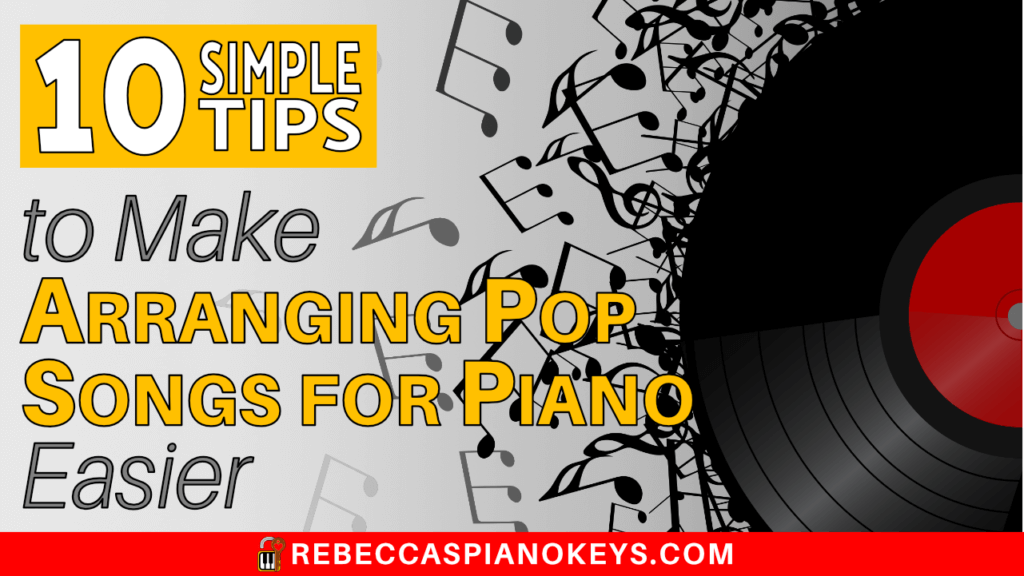Last Updated on September 12, 2021 by Rebecca
Featured image created using image(s) licensed by Ingram Image.
(Some of the links in this post are affiliate links. These don't cost you anything extra, but they allow me to earn a commission from your purchases. Read full disclosure here.)
If you ask me, the best way to learn pop songs for piano is to arrange them yourself. It's a great way to practice chords, develop your musical ear, and get familiar with the basic principles of music harmony.
I've always had a bit of a problem with piano covers of pop songs.
I love listening to piano covers of pop songs! And I've always felt a little envious of the people who play them. I always kinda felt like those people were the “cool” piano players. And I wished I could be like them.
But the problem is, I've always hated learning pop songs for piano. I own about a million books of sheet music for pop songs, and I've never learned any of the songs.
Why do I hate learning pop songs so much? Well, there are 4 main reasons:
- They're often really repetitive and simple. To the point where I zone out while playing, and then I get lost and can't figure out where I am in the music. (Oh shoot, I was supposed to repeat that pattern in the left hand for 16 measures. Has it been 8 measures or 9? 12? 14? *flips piano and walks away*)
- And if they're not super simple, they're super difficult (Jarrod Radnich, anyone?). Apparently there's no middle-ground. And, honestly, I feel like a lot of the people who arrange advanced versions of pop songs pack so much “showy fluff” into the music that it takes away from the spirit of the original song.
- They are so long! Like, usually around 4-10 pages, with repeats in them. I hate page turns, and I don't have room to spread that many pages side by side on my piano. And if we're being honest, I just don't have the patience to deal with 10 pages of either easy drudgery or super advanced finger acrobatics.
- They tend to incorporate a lot of octaves, which is frustrating for me since I have very small hands. (For real, it's a struggle for me to even reach an octave.)
If these things aren't issues for you and you love learning pop songs on piano, Sheet Music Plus is a great place to get sheet music. You can order physical books of song collections, or you can order individual songs for immediate download.
Just type the name of your favourite song in the search box, hit search, and see what you find!
But if you're like me and the issues I mentioned above drive you crazy, then you'll probably love creating your own piano arrangements of your favourite songs!
Because when you create your own arrangements, all the issues disappear!
- When I'm arranging the music myself, my brain is always engaged and focused. It's like a musical jigsaw puzzle. It's mentally stimulating, and it brings out my competitive side. (Picture Barney Stinson yelling “Challenge ACCEPTED!“… that's me when I pick a new pop song to arrange!)
- I can decide for myself what the difficulty level will be. I can make it simple, or advanced, or (*gasp*) I can even arrange it for those of us who like the middle ground! And I can decide for myself how much “showy fluff” I feel is appropriate to the song.
- Also, when I'm arranging the songs myself, they don't seem so long. Again, because my creative brain is so actively involved in the process. (What? That part I just finished is already 3 pages long? How did that happen?)
- And finally, I can choose my own chord styles, so there's no pressure to deal with too many octaves.
Oh, and did I mention that if you arrange your own piano versions of pop songs, you can sell your sheets?
Arranging pop songs for piano is something that I enjoy purely as a hobby, and once I've completed a piece, I can upload the sheets to SMP Press to make a bit of spare cash.
Is there anything more satisfying than making money from something you were going to do anyway just for fun?

My Piano Arrangement of Silence by Marshmello ft. Khalid
So as an example, here's my recent arrangement of the song Silence by Marshmello (ft. Khalid).
When Spotify published it's list of “Most Streamed Songs of the Decade,” I was inspired to start creating some piano arrangements of songs from the list.
I was going through the list to pick some that I might want to work on, and my boyfriend got really excited when I mentioned Silence, so I moved it to the top of the list. We'll just have to wait and see how many more I get through before the end of 2020!
But you came here for the tips!
And I won't keep you waiting any longer. Keep reading (or Pin for later!) to find out my 10 simple tips that will make the whole process of creating your own piano arrangements of pop songs a whole lot easier! (Or at least a little bit easier?)

1) Find chords online… but don't trust them.
Really, all you need to get yourself started is the key. The key tells you what notes to use for the melody, and it also helps you identify which chords the song is likely to use. From there it's a simple matter of testing out the chords to see which ones fit with the melody.
And if you don't yet have the skill to figure this stuff out on your own, feel free to find it online!
There are websites online where you can find the key and chords for just about any song you want. (My favourite is Ultimate-Guitar.com.)
Using one of these websites to find the key and chords of a song is not cheating!
So don't feel bad if you need to do it.
You're only using the provided chords as a starting point, to orient yourself and point yourself in the right direction. Your final arrangement will be a lot more complex than just a list of chords, so you'll have ample opportunity to do a lot more “on your own” before you're finished.
BUT, whatever you do, don't just blindly trust the chords you find online!
Test them first. I can't stress this enough!
Play these chords (in simple blocked form) along with the music and use your ear to decide if they sound right to you. If they don't sound right, trust your gut (or in this case, your ears!) and change them to something that does sound right!
2) Beware the capo!
If you're getting your chords from a guitar tab site, remember that guitarists use capos all the time to transpose songs into chords that are easier to play.
So if a songs says its in the key of A major, but lists the chords G-D-Em-C and says to put the capo on the second fret… those chords are not actually the chords you want at all!
The capo raises the pitch of everything by 1 half step for each fret (second fret = 2 half steps). So in this example, you'd be physically playing the chords G-D-Em-C, in the key of G major, but because of the capo, your guitar would be producing the sounds of the chords A-E-F#m-D, in the key of A major.
So if you wanted to arrange this song for piano, in the original key of A major, you'd have to remember to take the capo into consideration and transpose all the indicated chords back into their original key.
Just remember to transpose your chords up by 1 half step for each fret in the capo indication. Capo on 1st fret = 1 half step; capo on 2nd fret = 2 half steps; capo on 3rd fret = 3 half steps, etc.
3) Start with simple blocked chords in the left hand.
Once you've got the chords figured out, just play (and notate) them as simple blocked chords for now.
In pop music, the melody is king. So you'll want to figure out the melody first, before you start getting fancy with your harmony. This way you can make sure the harmony you create enhances and embellishes the melody and doesn't overpower it.
4) Use your voice to help find the melody.
Remember to use your key signature to determine the notes you'll use in the melody. There might be a few notes here and there that are taken from outside the key, but for the most part, the melody will be built using the notes from the home key of the song.
Still having trouble picking out the melody?
Remember to do very small chunks at a time. Like, one phrase, or even one small portion of a phrase.
And sing along to make transitioning the notes from your ears to your fingers easier. But do the transition in stages, like weaning a newborn.
- Just listen to the phrase a few times.
- Sing along with the phrase until you feel confident that you know it.
- Sing the phrase without the music playing, to make sure you've got the melody really ingrained. (This is important to make sure you don't second-guess yourself in the next step.)
- Sing the melody slowly, while playing around with the keys on your piano to find the notes that match what you're singing.
**BONUS TIP: Most melodies that are written for vocals stick within a single octave, and there aren't usually many big leaps. Steps, skips, and repeats are a lot more common than you realize!

5) Expect rhythm to be tricky.
Once you can play the song (or the section of the song you've been working on) you might think you're golden.
You might be thinking something like “Yay, I can play the song!”
And if that's your only goal, then congratulations, you're done!
But if your goal is to notate it and make a sheet music arrangement, the fun is just getting started.
For me, notating the rhythm of what I'm playing is the trickiest part of the whole process. So if you experience the same thing, don't give up!
Know that you're not alone. And know that you will be able to figure it out, and it will get easier with experience!
6) Count on your fingers.
If I'm stuck on one extra-tricky part of the rhythm, I'll count it out on my fingers. (Hey, it works for 6-year-olds in math class, so why not?)
I'm sure you've got a handle on tapping along to a beat, either with your foot, or by clapping, or by tapping your palm on your leg.
Now take it a step further and assign each beat to a different finger. Tap beat 1 on your leg with your thumb, beat 2 with your index finger, beat 3 with your middle finger, and beat 4 with your ring finger.
Now sing along while you do this.
This way you can physically see and feel which beat each syllable of the lyrics lands on. (Or which beats they land between.)
7) Beware swung 8ths, tuplets, and rests!
Swung 8ths
Swung 8ths are not too difficult to spot. You just have to remember that they exist.
Any time you catch yourself thinking: “Oh, this is just a repeated pattern of a dotted 8th note followed by a 16th note,”… just stop yourself right there.
Ask yourself, what musician in their right mind would write out a rhythm that annoying? All those little dots on the 8ths and half flags on the 16ths. And the need to constantly count 1 e & a even though nothing ever happens on the e or the &.
The answer is no musician would do that.
Those are swung eighths.
Just notate them all as 8th notes, put a note at the top of the page to indicate the piece should be played in swung 8ths (or swing rhythm) and everyone will know what you mean.
Tuplets
Tuplets, on the other hand, are a lot more sneaky. Especially when they're spread out over multiple beats.
So if you ever find yourself pulling your hair out because what you're playing is not a quarter note, or an 8th note, or a 16th note, and you're left thinking: “Those are all the note value options it could be, but none of them are right!”… stop and ask yourself if it's tuplets.
It probably is.
And tuplets are actually a lot more common in pop music than you might think.
Rests
Rests are also crafty little devils.
If you're not paying attention, your ear won't even notice they're there. And then all of a sudden all your notes are falling on the wrong beats and you can't figure out why.
It's because you missed a rest.
Go back and count it out on your fingers as explained in Tip 6, and you'll see where you missed your rest.
And yes, sometimes you'll find rests mixed into your tuplets, so keep that possibility top of mind too.
8) Use the lyrics to your advantage.
As you notate your arrangement, write in the lyrics with your melody line so you can see which notes go with which syllables. This will make it so much easier to keep track of which part of the melody you're working on.
9) Use software playback to check your work.
Remember in math class when your teacher always made you check your work?
It was like you had to do every question twice. The question asked you 9×6=? and you came up with 54? Yeah, you're not done yet. Now you have to also ask yourself what 54/6 is, and the answer better be 9 or else you have to start over.
You can check your work in music arranging too!
If you're notating your arrangement using notation software on a computer (my favourite notation software is MuseScore because it's free and very functional!), use the playback feature to listen to what you've written and make sure it sounds right.
It's like spell check. The playback feature will play the notes and rhythms exactly as you've written them, not as you think you've written them. So if you made any mistakes, you'll notice them right away when you hear the playback.
10) Save embellishments for last.
Vocalists do a lot of fancy trilly things when they sing. Don't worry about notating these embellishments at first. Just notate the basic melody line, then come back later to add the fancy trilly bits.
Also, consider adding harmonic intervals here and there in your melody line flesh it out and make it sound more full.
Arpeggios in the harmony often sound really good in the spaces between phrases within a melody. A bit of instrumental theatrics while the vocalist is taking a breath.
And if you want your harmony to be more elaborate than simple blocked chords, now is the right time to change it up and decide on a left hand pattern to use.



